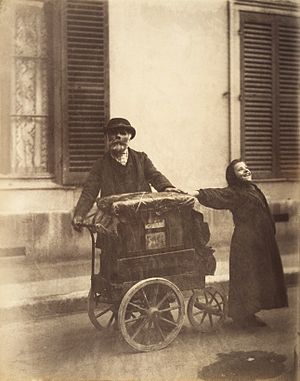The human element
| Art Appreciation and Techniques (#ART100) | |
|---|---|
| Artistic media: The camera arts | Overview | Introduction | Early development | Impact on other media | Form and content | Darkroom processes | The human element | Color images | Photojournalism | Modern developments | Film, video and digital | Summary |
Eugène Atget (pronounced “Ah-jay”) (1856-1927) was one of the first to use the photograph as a cultural and social document. His images of Paris and its surroundings give poetic witness to the buildings, people and scenes that inhabit and define the city.
The work of Diane Arbus (1923-1971) challenges us as we gaze at others who are deviant, marginalized or stand out because of the context in which we see their normality. Arbus’ lens is unflinching in its honesty. She presents images of strangeness and alienation without condescension or judgment. It’s up to us to try to fill in the blanks.
Many of the photographs in Robert Frank’s series, The Americans, depict groups of people in different situations, including riding a bus, watching a rodeo and listening to a speech. His photo essay on American life is seen through the eyes of an observer, not a participant. Instead of voyeuristic, they give a sense of detachment. Only a few of the figures look directly into the camera or directly at other people in the photo. Frank worked hard to maintain the observer’s point of view. Similar to Arbus, the photographs carry overtones of alienation – between the individual and the group. Controversial when first published in the United States in 1959, the book now is seen as one of the most important modern photographic social commentaries.
